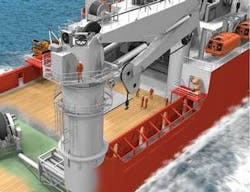NOV spearheads wide-ranging crane, winch development
Jay Schempf, Special Correspondent
Recognized around the world as a leading supplier of high technology driven drilling solutions, National Oilwell Varco (NOV) also is a leading supplier of cranes and winches through its Lifting and Handling Solutions Group.
The group includes such brands as AmClyde, BLM, Hydralift, Molde, and Unit Mariner.
Richard J. Juelich, group vice president and general manager, said the company is engaged in four main thrusts in the offshore industry’s heavy lift and load-handling area.
For the drilling and platform rig market, NOV is developing a new, all-electric pedestal crane designed to meet both API 2C 6th Edition and EN 13852-1, a relatively new offshore crane code implemented in Europe in 2004. The European specifications call for an automatic overload protection system (AOPS), which requires a means to release the load automatically in a matter of milliseconds should the crane hook snag during load transfer between the rig or platform and a vessel alongside. The response is in the payout direction to prevent dynamic overload of the crane structure.
NOV meets this requirement by designing the lift hoist such that rapid reversal of the inertia of the system - from inhaul to overhaul - is possible without requiring a separate hydraulic compensation,” say NOV officials.
At the heart of the new hoist design is a permanent magnet (PM) motor, which provides the high-torque, low speed necessary for crane hoist applications and results in a significantly reduced system inertia, which allows for rapid reversal from an inhaul to an overhaul condition during AOPS operation. The hoist design goes a step further, integrating the PM motor inside the hoist drum barrel and adding an integral planetary and motor brake.
Small footprint
In the construction vessel market, NOV is expanding its product offering (currently up 7,700 metric tons) by developing a post crane product line designed for combination vessels on which pipelay operations are the primary consideration.
The new NOV post crane has a small footprint, which allows for increased deck space for pipe storage,” company officials said, adding that the all-electric crane has good workability over the stern. Its drives and hoisting equipment are contained within its stationary central post, which is positioned on a rotating carousel. The boom and deck rest on a special bearing arrangement designed by NOV engineers (patents pending), using the experience gained by the company’s wholly owned manufacturers, who have developed many of the world’s largest offshore cranes. Also, there’s no limit on the size of the bearing, which can be inspected and repaired easily in place, if necessary. Current development is in the 1,000- to 3,000-ton capacity range.
For the floating production market, NOV currently supplies custom-designed cranes and mooring and riser pull-in systems, as well as large turret bearings.
In an effort to improve the life of mooring systems, NOV has developed the CMSF Series Stopper Fairlead. This rotary fairlead is fitted with an integrated, claw-type chain stopper (patents pending).
Combining the Stopper
The Stopper Fairlead addresses chain wear and fatigue problems inherent to standard rotary fairleads used in long-term mooring applications. The design incorporates an outboard-mounted chain stopper that pivots on bushings lubricated with seawater. These bushings compensate for the change in the mooring line vertical departure angle resulting from vessel motion, which eliminates the inter-link wear and fatigue common to conventional fairleads. Additional design advantages include direct mooring line tension measurement via load pins in the stopper links, reduced hull structure resulting from localized chain loads, and fewer moving parts.
Finally, for the multipurpose vessel market, NOV is designing new heave-compensated knuckle boom cranes with deepwater lowering capabilities, as well as large electric anchor-handling winches.
The Active Heave-Compensated (AHC) system can help minimize subsea operations costs by reducing severe weather downtime. “The system is designed to compensate for sea states by detecting actual vessel motion via an ‘intelligent’ load-handling system,” company officials explained. With this system, landing or lift-off from the seabed occurs at the most appropriate moment to prevent excessive loadings on the wire rope. The AHC system offers motion compensation up to 97% of the boom tip motion, and the system’s accumulator pressure vessels reduce the power required from the vessel by 75%. The knuckle boom configuration limits the “pendulum” effect experienced by standard cranes when working on deck or during supply vessel loading/offloading operations.
Winching anchors in any weather
NOV also has developed electric anchor-handling winches. Currently in production is a winch with an AC variable-frequency drive that features a self-diagnostic and faultfinding system, with a single-line pull capacity of 600 mt. It spools 3,500 m (11,480 ft) of 100-mm (3.9 in) wire rope operated with 5,400 installed horsepower.
Also, the winch features the LoadLim system (patent pending), which raises the operating weather window significantly since it disconnects the drive motors from the system, protecting them from unexpected, potentially damaging overspeeds.
For more information about the company’s new crane and winch products, contact Juelich by phone at 651-293-4615 or by E-mail at[email protected].

